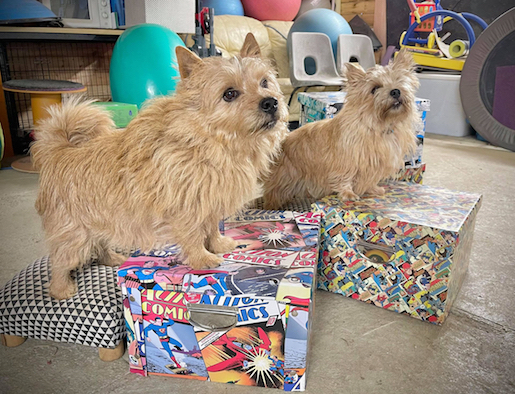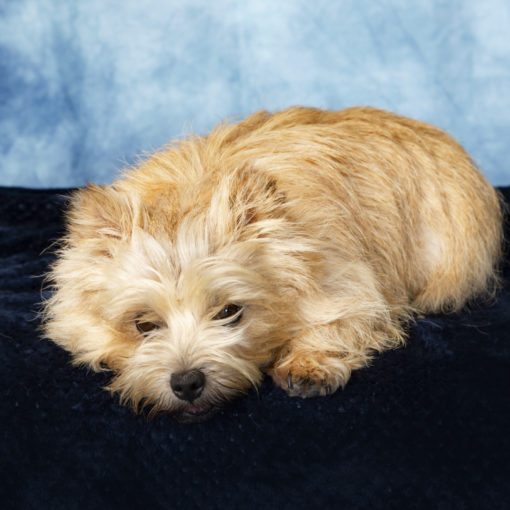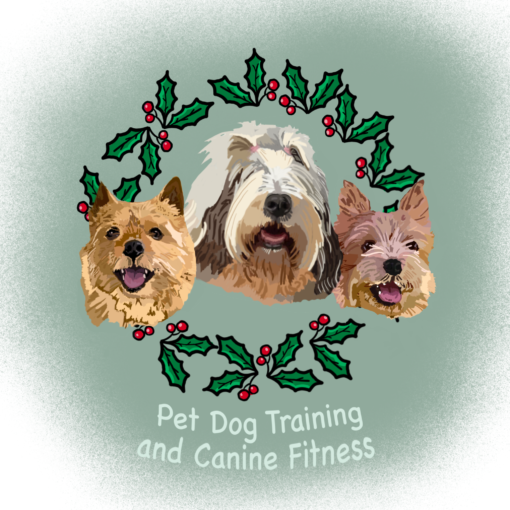
Moving house is a huge event in our lives and can be very stressful for us dog owners with trying to prepare the house for viewings, showing people around (especially during CoVid the last year!), keeping the house ready for people to view, finding our next home, putting in offers, sorting mortgages, packing up our belongings, preparing for the big day, the move itself, and unpacking at our new home.
Now consider how all this may affect our dogs!! With changes in us our dogs notice and can be affected, such as when we are stressed or worried. When we start boxing our belongings or putting into storage this can be confusing for many dogs as the house changes with the presence of boxes while items and furniture they may be used to having nearby suddenly disappears and can even interfere with their usual routine. The move itself can be really distressing for even the most laid back dog, and even more so for a dog that already finds situations stressful, and then settling into a new home takes a lot of work as dogs do not naturally like change!
I am moving house myself in June 2021, which will mean moving from my Bungalow of 8 years to our new House in another town along with Jon, our two Norwich Terriers, Merlin and Ripley, our House Duck Echo, plus 2 Quail, then our outdoor birds including 12 Ducks, 2 cockerels and 16 hens!! All being moved along with our furniture and belongs on the same day!! So I have of course already started preparing our dogs, and other pets, for the changes that are coming soon, starting with our current home. This blog will hopefully provide some help and guidance to prevent our dogs becoming overly stressed during Moving House, as well as additional advice for families who have dogs who tend to suffer with Separation Issues and Anxiety that are likely to find moving house much more daunting.
Preparation for our Dogs while we are starting to sort our belongings:
Once we know we are moving house we begin the mammoth task of packing our belongings into boxes and storing them around the house, or moving items into external storage until we are in our new home. This process means lots of small changes happening at once which is unusual for our dogs and can cause them to worry about what it means and what is happening.
From our dogs’ perspective bear in mind that when we are putting our household items into boxes, bringing items out from the loft and clearing out cupboards and drawers there will be a lot of new scents which can overload our dogs. Dogs are incredibly good at using their noses so to have a sudden onset of multiple scent hitting them will cause them to be overloaded and therefore tire quickly, and often when tired dogs can become confused more quickly or even a little ‘off’ compared to usual. As we are taking items out of drawers and putting into boxes there is likely to be a lot of clanking, banging, rattling and more so may disturb our dogs through unusual sounds as well as disturbing their daily rest, which again can cause dogs to feel anxious. If your dog is also noise sensitive this can really heighten their fears and put them in an emotional state that can take many days to calm from, especially if they are hearing new sounds over many days without a chance to rest in between.
As we are packing everything up we can often put boxes or furniture in a place where there usually isn’t anything which will change the layout of a room, or multiple rooms, and this can cause anxiety for dogs on it’s own as they are not comfortable with change generally, but also it may block the way to one of their favourite places to lay down or feel secure which can then make their anxiety increase – even if they usually are not an anxious dog! We might even move something like a rug, one of our dogs multiple beds or footstool that our dogs like to relax on without realising how much it is involved in their daily habits and this too can cause confusion.
So we can help our dogs by trying to not pack up things in every room at once, but trying to do some in one room and put the boxes somewhere your dog doesn’t go that much, then start another room etc. Be aware of what your are packing and make use of packing paper or bubble wrap to minimise noise – which will help when you unpack in your new home too. Consider where your dog tends to be in the home, especially if they follow you into each room, and try to position boxes or moved furniture in a way that doesn’t block their path too much or restrict access to their most comfortable and relaxing places. If you are storing items try to keep some of your dog’s most treasured blankets, beds, toys – even cushions – until the very last moment to help them adjust. It’s also worth having windows open or see if you can shut your dog out of the room if you are taking lots of items out of drawers and cupboards that may have mixed scents and fragrances which can overload your dogs’ senses.
During the packing and loading processes:
Often we will have a bulk of packing to do near the moving date, even if we have a lot boxed up or even put into storage. Things like the larger furniture pieces, clothing, cleaning products etc are more likely to need sorting the same week as moving so this can be when the majority of dogs will show some level of stress or uncertainty as there is more happening in a short space of time. This is therefore the time we need to try and continue our dog’s routine where we can, such as meal times, walks, times set aside for play and interaction, grooming etc.
Having routines for our dogs means they have times of the day where they know what to expect, when the activities and surroundings are going to be familiar to them and even sometimes something they look forward to! It can sometimes be difficult to maintain some parts of our dogs’ routine but doing what we can will certainly help. Mealtimes are an area that has several elements for dogs such as time of meals – dogs have amazing body clocks – and what they have their food in (eg bowl!), where they eat it such as on the floor, in their bed or crate, outside in the garden etc, whether you usually sit with them while they eat or not, are there any other pets in the same room while they eat etc. Maintaining as many elements as possible can really help so even if your dog can’t go to their normal spot to eat as it’s been packed away or there are boxes in the way you can still keep to a similar time, use the same dish, stay with your dog if that’s what you usually do, etc. Check you have enough of your dog’s food too as you don’t want to run out the day you move then need to get more instead of unpacking in the first couple of days!
Keep an eye on your dog and if possible consider confining them to one area of the house so you can focus on phong boxes etc and your dog can have a nice safe area to observe everything or have a nap. Baby gates can be really useful so your dog can see you and you can see them but know they are secure and safe. You could also make use of crates and puppy pens if your dog is comfortable using these. Crates and pens are extra handy if you live in a very open plan home so there isn’t anywhere to keep your dog safe or you need the room your dog is in! Crate training tips can be found here : https://youtu.be/db0M2p8w9KM
| Crate Training Foundations TalkWhy use crates? How to introduce to your dog, what Crate to use? And more! Presented by Joe Nutkinsyoutu.be |
If you see your dog is looking anxious or stressed, or would like to prevent risking them becoming worried, you can use things like essences and remedies to offer to your dog and they can ‘select’ what they are needing at the time. You may have heard of Bach Rescue Remedy which can be useful for a dog who is worried and ideally needs to go in the water bowls early on to have a chance e of getting the remedy into the dogs system. Just put 4-6 drops in their water depending on size of the bowl each time you change the water for at least a few days before the move itself. Alternatively there are other types of essences including individual essences which have their own properties such as White Chestnut is good if your dog cannot settle, or Star of Bethlehem for life changing experiences and to provide comfort.
Look into Zoopharmacognosy, or Botanical Self Selection, which is a way for your dog to select what they instinctively know they need. Most dog owners have seen a dog seek out a particular type of grass to chew on when they feel nauseous or have suddenly started chewing up paper tissues – these are both forms of self selection where dogs understand what is needed. Practitioners can help remotely and in person and can really help with the big changes involved with moving house!
If you know massage or TTouch then you could try a little of this every day or two in the lead up to the move to help calm your dog and reduce tension and you might even find it beneficial for yourself to focus on your dog as well!
The Day of the Move:
On the day of the move it can be beneficial for dogs and for us if they can stay somewhere out of the home that they are comfortable being at. For example they might be happy staying with a family member or a friend, or going to a pet sitter, pet hotel or kennels. By giving your dog a mini break they don’t become caught up in the hustle and bustle of items being moved about, people talking, potentially things being dropped etc and we don’t need to check we haven’t accidentally let the dog out into the main road! If a dog is happy to stay with someone you could even think about taking them the day before the move so they are completely out of the chaos and the day of the move you won’t forget mealtimes, to let out to toilet etc.
This isn’t going to be an option for everyone or for every dog, and I wouldn’t have done this for my own dogs personally but if I had a nervous dog, or a dog with specific needs etc then I would definitely arrange for somewhere quiet and cosy they can stay!
If your dog is with you on the day of the move don’t forget to plan how your dog is getting from the old home to the new one! It might sound obvious but sometimes where we are merrily packing everything and have a deadline we can get carried away then go to lock the house up and realise there is nowhere in the car for the dog or that you only have the removal van let and your dog normally travels in a crate!
Plan ahead on how your dog will travel and what they might need.
Car harness, leads, crate, bed, water bowl (and water!), poo bags of moving further away or for when you arrive, treats or your dogs next meal, any meds they need? Ensure these are to hand and put them where you will need them ready for the final drive. If you’re taking your dog in a vehicle that is different to usual get the crate ready, or the back seat protector, or the car harness etc so you know the space is set up ready.
However don’t forget the outside space safety too!
Once you have brought your dogs into your new home give them a chance to have an explore but be vigilant! I’d recommend keeping them on a lead for that initial moment unless you’ve been round to check there’s nothing dropped on the floor and you’re either sure your dog won’t go to the toilet on your furniture or don’t mind if they do! Going somewhere new will create a host of new stimulus for dogs including new scent and if that also includes the scent of pets that previously lived in the house there can be an increased chance of covering scent by toiletting! Other scent such as the last owners perfume, new carpet smell etc can be overwhelming for dogs so getting them outside gives them a chance to calm and get their senses under control again.
So after a brief investigation it’s time to take your dogs back outside as the new stimulus is likely to cause excitement so taking outside to give them a chance to go toilet and then to have a bit of a sniff about which can help dogs feel calmer and settle into new surroundings. Before heading outside however, if you have a garden you may want to have a check around the perimeter to enter sure there’s nowhere your dog can escape through such as broken fencing or under hedgerows as with there having been a lot of changes already your dog might find an escape route tempting to follow or may be following a scent! You could keep your dog indoors while you check the garden or just take them outside with their lead on to keep them safe! It’s also worth having a check in the garden or driveway etc to ensure there’s nothing that has been left that could be hazardous to your dog.
Once back inside you’ll be busy putting boxes in the correct rooms, moving furniture inside etc so it’s best to pop your dog somewhere they can be safe as well as not a trip hazard! This might be in a room not being used too much with the door shut or a baby gate across the doorway, or could be in a puppy pen or crate if they are used to being in one of these and you have more of an open plan layout. This way you can get on with what you’re doing or your removal team can continue without the worry that your dog can escape out of the open front door or be injured if something being moved falls on them. Don’t forget they are there though – they will need toilet breaks, whatever time their dinner usually is, possibly a quick walk if they don’t toilet in a garden, access to water, their bed or a blanket so they can settle if they want to and even some toys or an interactive toy with treats inside.
The first night, and maybe even the second night, there will still be many things out of place, boxed up, not in it’s final location but something that you can do to help your dog settle is put some things where they might expect it to be; water bowl in the kitchen if that’s where it was previously, their bed by the sofa or next to your bed if that is what they have been used to, toys in a basket or box somewhere easily accessible etc.
Then we are on the home run!! We can start bringing regular routines back into place such as meal times, walk times, grooming sessions, playtime opportunities and more! Once your dog can start seeing that despite a new house layout, or changing from bungalow to house with stairs, the important things to them are still in place they will settle much more quickly even if you are having new furniture being delivered over the coming weeks or need to have some work done around the house or garden. If you find your dog is a little unsure about their new home you can look at helping them with supplements, Botanical self selection etc again or there are Dog Trainers and Behaviourists who will help with your dog’s worries.
What if your dogs needs a little extra guidance?
For dogs who have a history of separation issues or anxiety, or for dog who may have some cognitive difficulties, or are challenged visually or audibly you may find our next blog of help where we explore ways to help dogs with special requirements to settle into new surroundings. To be sure to receive a notification when this next blog is ready don’t forget to sign up to our blog mailing list!!
Thankyou for reading – and Happy New Home!
Joe Nutkins
Kennel Club Accredited Dog Trainer,
Certified Professional Canine Fitness Trainer,
Certified Trick Dog Instructor
CAM Level 1 Certified (Canine Arthritis Management)
Dog Training for Essex & Suffolk



